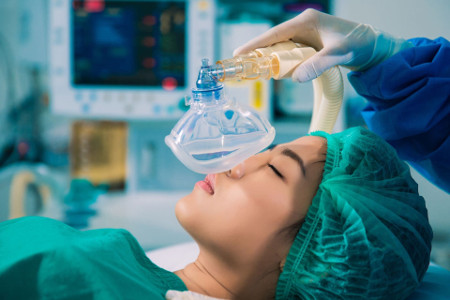Poltava, prospekt Vitaliia Hrytsaienka 9 Weekdays: 8:30-15:00, Weekend: weekend +38 (0532) 56-02-11+38 (095) 688 25 07
Selection of plasty with local or general anesthesia
 The desire to get rid of their own defects leads more and more patients not only to cosmetologists for the course of plasmolifting or injections of beauty, but to plastic surgeons as well. The subject of discussion includes the desired parameters of face and body correction, duration of surgery or rehabilitation period as well as anesthesia. The question of the sensitivity level during surgery or fear of pain often only prevents the patient to decide on the profound changes.
The desire to get rid of their own defects leads more and more patients not only to cosmetologists for the course of plasmolifting or injections of beauty, but to plastic surgeons as well. The subject of discussion includes the desired parameters of face and body correction, duration of surgery or rehabilitation period as well as anesthesia. The question of the sensitivity level during surgery or fear of pain often only prevents the patient to decide on the profound changes.
Why is anesthesia necessary?
- It guarantees the safety of patient's life and minimizes the risks.
- It allows the surgeon to perform his work qualitatively.
- It eliminates the risk of stress in the patient and anaesthetizes the patient.
- It allows to perform monitoring of blood pressure, respiratory rate, heartbeat and blood flow.
What are the types of anesthesia?
 In case of local anesthesia, it is not necessary to involve the anesthesiologist; the surgeon can carry out the procedure on his own. The anesthesiologist performs 2 categories of anesthesia:
In case of local anesthesia, it is not necessary to involve the anesthesiologist; the surgeon can carry out the procedure on his own. The anesthesiologist performs 2 categories of anesthesia:
- Intravenous introduction of the drug allows relieving the patient of stress and preserving his consciousness at the same time. After that, the body can be gradually put into a state of general anesthesia. It is divided into three types in anesthesiology:
- The condition of light slumber with the preservation of the reaction to the voice commands (sedation);
- Superficial sleep, which allows the patient to get rid of the excitement and stay in a comfortable condition (deep sedation);
- General anesthesia.
- Local anesthesia allows anaesthetizing a certain part of the body. The most popular types of anesthesia are:
- Spinal anesthesia - the introduction of anesthetic in the subarachnoid space to block the transmission of the pulse at the level of spinal nerve;
- Epidural anesthesia - introduction of the drug in the epidural space of the spinal column through a catheter;
- Regional anesthesia.
Methods used to perform anesthesia.
When carrying out of plasty, the basic parameters of anesthesia selection are the following criteria:
- Safety of the patient;
- Estimated duration of the procedure and its complexity;
- Necessity of patient's stay at the hospital during the postoperative period.
- Simple and short operations (microliposuction, chin or ear correction, eyelid surgery).
In this case there is no need for hospitalization of the patient. Due to superficial sleep and local anesthesia, the patient can follow the procedure and leave the clinic in a few minutes after it is completed.
 Due to the combination of drugs having different duration of action, the effect of anesthesia comes quickly and is being held after the procedure. This method is characterized by the following advantages for the patient:
Due to the combination of drugs having different duration of action, the effect of anesthesia comes quickly and is being held after the procedure. This method is characterized by the following advantages for the patient:- Deep anesthetization is performed;
- There is an almost complete absence of any memories;
- In a few minutes after the procedure, the patient can leave the clinic in complete clarity of consciousness;
- There is no pain and nausea during the postoperative period;
- Complete safety is guaranteed not only during the procedure, but in the postoperative period as well.
- Plastic surgery of average duration and difficulty level (mini-surgery of the face, breast augmentation, liposuction, nose surgery).
The following factors are taken into account when choosing the method of anesthesia:
In accordance with the listed criteria, it is possible to perform an operation under general anesthesia in its light form or under local anesthesia with a superficial sleep. Regardless of the method chosen, the patient may leave the clinic on the same day.
- Safety for the client's life;
- Aspects of surgical intervention;
- Health level of the patient;
- Patient's wishes.
- Complex plastic surgeries with general anesthesia (extended facial surgery, breast lifting, breast reduction, abdomen plasty)
Regardless of the complexity of the surgical procedure, the use of advanced techniques in combination with modern drugs allows to achieve the following results:
- Absolute safety of the patient due to continuous monitoring of the state of his vital functions;
- Absence of memories related to the procedure;
- After performing the plastic surgery, the client does not feel pain and nausea;
- High level of the surgeon's efficiency;
- Freedom of movement immediately after the procedure;
- The patient is dismissed on the next day in the morning.
What causes the fear of anesthesia?
- As a rule, the patients are not related to medicine and therefore they do not know anything about anesthesiology.
- The client of the clinic has the opportunity to get acquainted with the plastic surgeon in person long before the plastic surgery and can have a consultation with him regarding all the issues. Acquaintance with the anesthesiologist occurs immediately before the procedure.
- Sometimes, a person is triggered by the instinct of self-preservation and is afraid to lose consciousness and trust a stranger even for not a long time.
Is it worth to be afraid of anesthesia?
The risk of negative consequences of local or general anesthesia in a healthy patient is minimal. It is connected not only with a high level of qualification of doctors from our clinic, but also with the use of advanced techniques of anesthesiology, modern preparations, as well as due to constant monitoring of the physical condition of the client.
Medications used today have a high level of reliability, so the anesthesiologist has to make more than one mistake for the occurrence of complications, it is necessary to repeat the mistake. In addition, more than 20 functions of the body are controlled during the operation, and it eliminates omissions associated with the human factor almost completely.
specialists of the Clinic for Plastic Surgery
10-07-2018
Similar news
